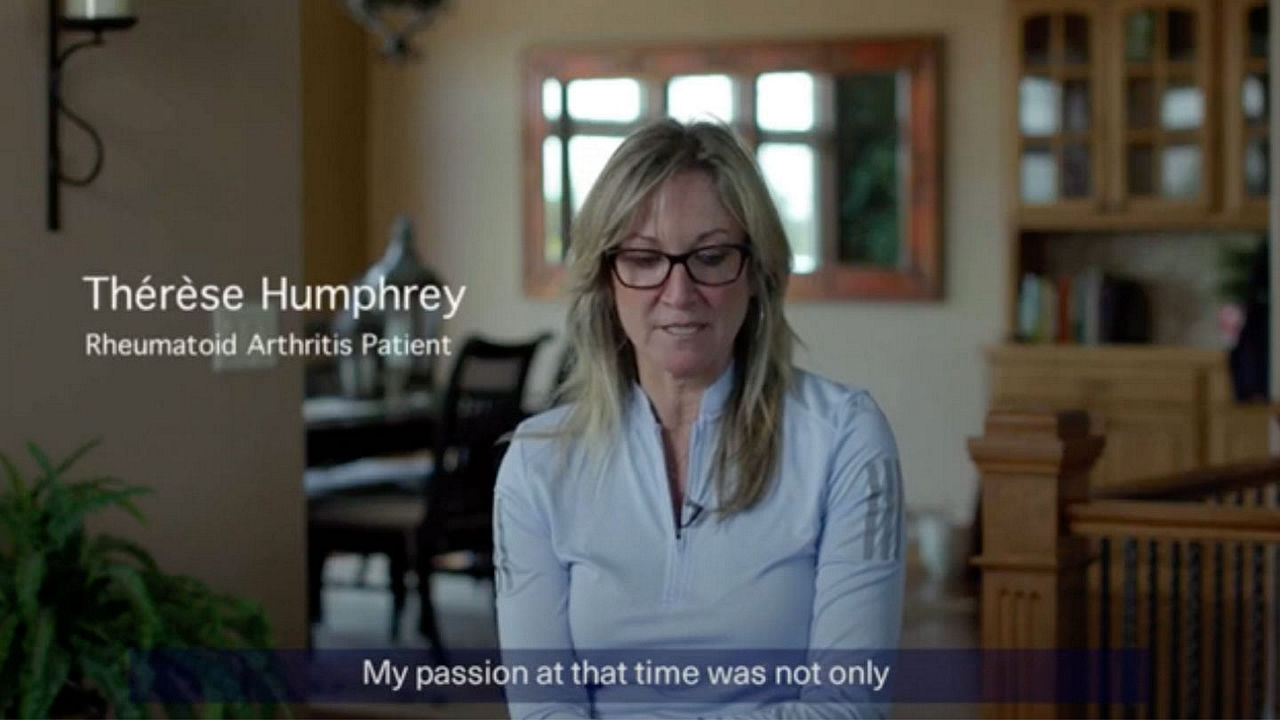Thérèse Humphrey, shares the many lessons she’s learned about RA.
Why you can’t wait with rheumatoid arthritis
Why is it important for people to see a rheumatologist sooner rather than later?
From treating patients to becoming one
Your early 20s can be exciting as you experience life as a young adult. New careers. New responsibilities. For Thérèse Humphrey that period is characterized by pain. “It was the summer of 1986 and I was very active and healthy,” recalls Humphrey. “But, in just a week or two I experienced symptoms of joint pain that came on so quickly I could barely get out of bed, and then came the swelling.”
Humphrey, a registered nurse, sought a rheumatologist and learned she had rheumatoid arthritis, a chronic immune-mediated inflammatory disease that causes pain, swelling and stiffness of the joints.1 Rheumatoid arthritis, or RA, affects an estimated 23.7 million people around the world, but when Humphrey was diagnosed there was no internet to connect her to other patients or help her understand what she can do to manage this chronic condition.2
“It was hard for others to understand what I was feeling. I was tired and I was in pain. I’m not lazy but these symptoms did affect my ability to work,” Humphrey says.
Advocate and educate
This is why patient advocacy groups, such as the Canadian Arthritis Patient Alliance (CAPA), are educating people and policy makers on the challenges and seriousness of living with RA. Laurie Proulx is on the board of directors. The education she helps promote is personal, as she was diagnosed with juvenile RA at the age of 14.
“One of the major barriers RA patients deal with is how it impacts them at work,” says Proulx. “We developed resources to help people with arthritis in the workplace and we’re helping employers understand this isn’t just a disease resulting in a little stiffness. It’s not just affecting elderly people. RA could mean a person needs to come into work a few minutes late because of the fatigue and pain they deal with when they wake up.”
As for patients, Proulx says CAPA is helping them understand the disease can affect more than your joints. After more than 25 years with RA, Proulx suffers from systemic problems because of the inflammation. “I have breathing impairment and cardiovascular issues,” Proulx explains. “My laundry list of medical visits and health issues that stem from not properly managing my RA include two reconstruction surgeries on my feet.”
CAPA’s goal is to get patients into a rheumatologist within four weeks of their referral from the family doctor. Proulx emphasizes early referral to see a rheumatologist is critical to helping manage the condition.
“People don’t understand this disease unless they’re personally touched by it,” Humphrey adds. “RA can affect not just your joints, but also your heart, your lungs, your eyes, your kidneys, your skin.”
Why setting treatment goals is important
Getting to a rheumatologist is critical, but as Humphrey and Proulx will point out, it’s just one part of the journey. Even with the availability of multiple treatment options, Aileen Pangan, M.D., executive medical director, immunology clinical development, AbbVie, knows that many patients are still struggling with moderate to severe rheumatoid arthritis.
“Undertreatment is when a patient does not reach the appropriate treatment goal within a specific time frame. Ideally, the goal is to reach a state of low disease activity or remission, a state characterized by almost no disease activity and symptoms,” says Pangan. “Timing is also important. Delaying your treatment now can impact patients even a few years later.”
To help stop the inflammation and progression of RA, Dr. Pangan encourages patients to work together with their rheumatologists to understand how the disease impacts each patient in order to set personalized treatment goals, aiming for either low disease activity or remission, depending on what is attainable for each individual person.
“I never give up hope,” reflects Humphrey. “I stress to those in the patient community that you can get through this disease. Don’t give up. Trust your rheumatologist, work as a team and be proactive in managing your health. I know for a fact today that with all the studies and research that have been done, if you treat this disease early enough there is possibility for remission.”
Media inquiries:
Email: [email protected]

